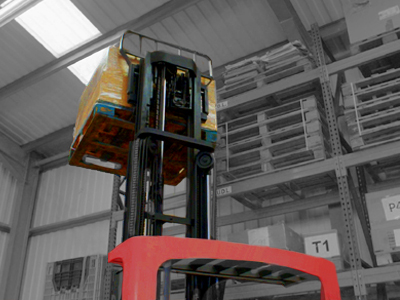 Stuart TaylorStuart Taylor is Managing Director of Mentor FLT Training Limited, the UK’s leading provider of training and associated services for all types of materials handling equipment and workplace transport.
Stuart TaylorStuart Taylor is Managing Director of Mentor FLT Training Limited, the UK’s leading provider of training and associated services for all types of materials handling equipment and workplace transport.
Tip-overs often result in serious or even fatal injuries and almost always involve stock and truck damage. But, by understanding the causes and how to avoid them, you and your operators can dramatically reduce the risk of this happening on your site.
Let’s take a look at some of the most common scenarios, as well as how to reduce risk in each case.
Insecure loads or overloading
A common contributing factor towards tip-overs is handling insecure loads or overloading the truck with more than it can safely handle. Not only can insecure loads fall and injure those in the vicinity, but the sudden loss can also affect stability and cause the truck to tip over. Regards overloading, if this occurs at ground level, the back wheels may lift. Overloading at height can cause the forklift to tip forward, potentially into racking, which will cause further damage.
To reduce risk:
- Secure loads with shrink wrap, straps or banding, then ensure they are picked up properly and fully heeled. Forks should be evenly spaced so weight is evenly distributed and the truck stays balanced.
- Understand and don’t exceed the truck’s capacity — make sure that operators know the difference between gross weight (load plus packaging and pallet) and net weight (load only).
 Handling raised loads
Handling raised loads
Handling suspended or live loads
Unsafe handling of live loads, or those suspended below the forks, is another regular contributor towards forklift tip-overs. For example, these could be bulk bags or loads hanging from an attachment, as opposed to loads sat on pallets. Unlike a standard palletised load, which is more likely to remain stationary in transit, a suspended or live load is far more susceptible to movement. If the operator does not understand and accommodate this, the increase in momentum can change the load centre of gravity so much that it causes the truck to tip.
To reduce risk:
- Drive at a sensible speed — to minimise the building momentum of the load
- Drive in reverse — this tends to mean driving slower and also ensures the operator’s view will be clear
- Place the load on a pallet — if the load allows, palletise it, e.g. if you have a roll of material to transport, don’t suspend it via a sling through the centre. Instead, lower it onto a pallet, place bearers either side and secure to prevent movement
- Reduce the transport distance — if the load must be suspended, minimise the amount of time it has to be carried in this way. Can you use another vehicle to get the load as close as possible before it’s lifted?
Turning with an elevated load
Turning with an elevated load is often a contributor towards tip-overs because turning at the same time as raising or lowering a load causes greater force to be applied to one side of the truck than the other, reducing stability. Laden trucks also become less stable the higher the load is lifted, so adding an additional manoeuvre at this point can only reduce stability further. Though turning with an elevated load is often perceived as a time saver, the delays, costs and consequences of a tip-over far outweigh any minor gains to be made.
To reduce risk:
- Carry out one operation at a time — eg. pick up the load, reverse, lower it to a safe position, then turn and drive away
- Ensure operators understand that perceived time-saving measures are not worth the risk of an accident
Traversing a slope or uneven ground
Driving across an incline or on a diagonal, rather than straight up or down, affects the lateral stability of a forklift truck, as the weight falls to one side, and can cause it to tip. The same principle applies when a truck travels over uneven ground; the weight becomes unevenly distributed and, combined with the momentum of the moving truck, can result in a tip-over.
To reduce risk:
- Only drive up or down an incline, never across it
- Always travel load uphill, forks downhill — if travelling with a load, it should always face uphill; if unladen, forks should face downhill. This will improve stability, traction and adhesion, and applies regardless of the direction the operator is travelling in
- Only drive on terrain for which the truck is built — if the truck isn’t designed for uneven ground and it is driven over rough terrain, it may not be able to cope with the demand, which puts the operator and their colleagues at risk
- Check the operating area — look out for curbs, potholes, debris, etc., and find clear routes that won’t compromise the stability of the forklift or its load
These principles of safe operation should all form part of your team’s forklift training. Follow this up with reinforcement of best practice and regular monitoring to ensure operators continue to work safely and you can significantly reduce the risk of accidents on your site.